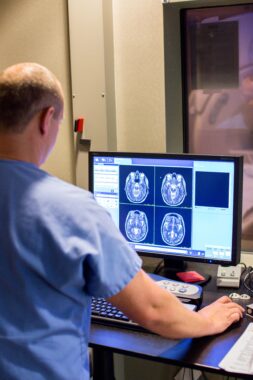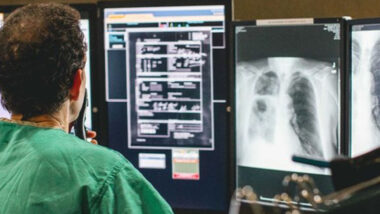Whether you’re an active athlete, an occasional gym-goer, or a person whose physical activity is limited, you’re at risk for a muscle injury. Muscle strains and tears can happen to anyone, no matter what shape they are in, and during all types of activities. Depending on the severity of the injury, you may need diagnostic imaging to help your provider diagnose damage to your muscle. Carolinas Imaging Services makes it easy to get imaging, so your provider can more quickly prescribe a treatment plan to start your healing process.
The Difference Between Strains and Tears
A strain happens when you overextend (or stretch) or forcefully contract a muscle to the point of injury. A strain can happen to a muscle or tendon, which is the soft tissue that connects muscles to the bones. A sprain, which commonly happens to the ankle, is damage to a ligament. Strains can range from mild to severe, depending on how many fibers in the tissue are torn. There are three grades of strains:
- Grade I: While it may still be painful, a mild strain results in just a few torn muscle fibers, and you still have muscle strength as usual.
- Grade II: With additional torn fibers, a moderate strain causes more pain, bruising and swelling, often with weakness in the injured area.
- Grade III: The most severe type of strain, this injury causes the muscle to fully tear. There may be a “pop” when it happens, along with acute pain and inability to use the muscle or limb.
Strains are more likely to happen in certain parts of your body, including your hamstrings (muscles on the back of your thighs), your hip flexors (muscles on the outside of your hip), your groin (muscles on the inside of your thighs), your calf, and your lower back.
Symptoms of a Muscle Strain or Tear
A strain has symptoms similar to other types of injuries, like sprains or overuse injuries, which include:
- Bruising
- Pain
- Spasms
- Swelling
- Tenderness
- Trouble moving the injured area
- Weakness or loss of muscle function
Mild to moderate strains can often be treated by applying ice, resting the affected body part, and taking over-the-counter anti-inflammatory medications. But pain that doesn’t go away after a few days or symptoms consistent with a Grade III strain needs prompt medical care. These symptoms include:
- Misshapen-looking muscles
- Numbness
- Signs of infection like redness and warm skin
- Trouble bearing weight
It is important to seek medical care because severe strains may need surgery to heal properly. Even moderate strains may require physical therapy or other treatment to bring the muscle back to regular use.
Read More: Differences Between MRI and CT Scans
How an MRI Can Help Diagnose a Strain or Tear
If you have a severe strain or ongoing pain that hasn’t gotten better with rest, your sports medicine provider will likely take an X-ray to make sure nothing is broken. But an X-ray will not tell your provider what’s happening in the soft tissues in your back, calf or thigh.
To see any tears or other damage to your muscles and tendons and possibly ligaments, he or she will need to order an MRI scan, also called magnetic resonance imaging. This type of advanced medical imaging uses strong magnetic frequencies (with no radiation) to create a more complete picture of the inside of your back or leg than an X-ray.
A physician must order an MRI for a patient. Luckily, Charlotte Radiology’s multiple locations make it easy to get the imaging you need close to home. With a tricky injury like a strain, you need high-quality and precise diagnostic imaging. Trust Charlotte Radiology for your MRI needs.



